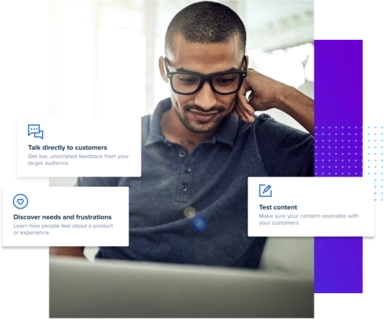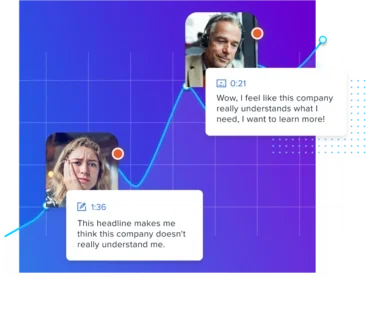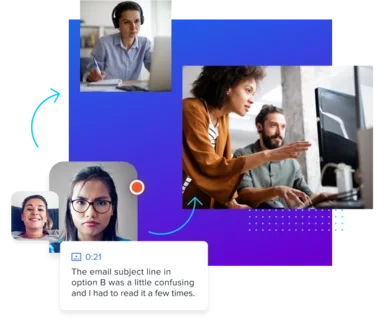
In this guide
Human insight: how marketers stop guessing and start understanding
Human insight: how marketers stop guessing and start understanding
In today’s fast-moving world, marketers need to adapt in real time to the constant change of customer behaviors, preferences, and needs. To drive growth and stay one step ahead of the competition, marketers must go beyond data to understand what motivates customers to take action—and how perceptions, expectations, and emotions play a role in the decision-making process.
In this guide, you’ll learn why human insight is critical to great customer experience (CX), get actionable tips and use cases, and discover how all marketing teams can harness the power of feedback in their content and campaigns.
Why insight is the missing link for many marketers

In an annual UserTesting survey, 79% of marketers agreed that great CX is critical to success, yet even more, 87%, admit that their company’s overall CX needs improving. Traditionally, gathering customer feedback can be challenging. Teams who aren’t experienced researchers are tasked with:
- Preparing questions to ask participants
- Finding the right customer audience
- Finding the time to speak with customers
- Engaging with customers effectively
- Analyzing feedback efficiently
- Sharing and shaping decisions with feedback
This is probably why many marketers lean on quantitative data to inform campaign, creative, and content decisions. Unfortunately...
Data alone won't give you the full story
Hear from the team at Microsoft to understand what you’re missing if you’re not talking to customers.

"Relying on big data alone increases the chances we’ll miss something, while giving us the illusion we know everything."
Tricia Wang
Technology Entrepreneur
Yet, with so many omnichannel touchpoints spanning from real-world to digital, marketers face challenges gathering feedback on every experience. According to UserTesting's industry report, marketers noted that:
61% | 63% | 63% |
Teams don’t have sufficient training to be customer-centric | They don’t have access to human insight platforms to help make customer-centric decisions | They don’t have a measurement framework in place to gauge the impact of customer-centric efforts |
Marketers don't get regular feedback
And while 73% of marketers report that their teams actively collect feedback, 53% also admit that it's hard to optimize every element of CX. In fact most assets are only tested half as often as marketers think they should.

How customer feedback informs confident decisions

Marketers play a central role in the success of modern companies—connecting products and services to customers. At the same time, they must balance business priorities like improving brand reputation, increasing customer loyalty, generating demand, driving revenue, and much more. Not to mention, the scope of responsibilities marketers face has only expanded as organizations attempt to keep up with the ever-evolving needs of the customer.
This leaves marketers little time to make decisions, often forcing them to rely on hunches gleaned from historical data and trends. Although analytics can help, they can’t explain what customers are thinking, let alone what they need. That’s essential information. To capture these actionable customer insights, marketers turn to traditional market research that typically takes far too long to fit within the already tight timelines marketing organizations are challenged with.
How human insight helps marketers
So how can marketers empower themselves to be the driving force behind a customer-centric (even obsessed) organizational mindset with what little extra time they have? This is where human insight, in the form of customer feedback, becomes a marketer’s best friend—and secret weapon.
This is where human insight, in the form of real-time customer feedback, becomes a marketer's best friend (and secret weapon) by:
 |  |  |
Driving growthPair customer feedback with quantitative analytics solutions to optimize your campaigns for conversion quickly, turning data into actionable insights. | Supporting a customer-centric cultureSharing customer feedback builds a more customer-centric team, ensuring that your brand resonates at all points in the customer journey. | Reducing costsYou'll save time and reduce costs while gathering competitive insights, validating content, and explaining data through remote feedback like live interviews and recorded feedback. |
Human insight empowers marketing teams
Quickly gathering insight directly from your target audience enables your team to directly connect with people who align with your ideal buyer personas, on-demand. Identify how customers naturally search for solutions to a particular challenge or need, remotely. By understanding your customer’s organic journey you can meet them where they are in the buying cycle and create meaningful experiences throughout their journey.

The ROI of customer empathy

Empathy may seem immeasurable, but to marketers, it’s a benchmark to live by. Why? Because empathy drives customer loyalty, and loyalty drives ROI.
Successful companies understand the importance of nurturing a relationship with their customers which requires trust, reliability, and most of all, an emotional connection—a connection that can be informed by building empathy through human insight.
52% | 95% | 60% |
Increase in value of emotionally-connected customers | Purchasing decisions driven by emotions | Loyal customers who use emotional language to describe their favorite brands |
Companies aren't as customer-centric as they think
Yet, despite all the evidence in support of gaining customer empathy, many companies aren’t as customer-centric as they think.
And while that gap may seem wide, fortunately, it’s not impossible to bridge—if you have human insight on your side. In the following section, we’ll dive into real use cases and examples of how marketing teams can infuse customer feedback directly into their processes to ensure campaigns and initiatives resonate with their target audiences—before anything is launched.

Using insights across your organization

It’s nearly impossible to predict the needs and actions of others. Which is why you probably shouldn’t. While it’s true that great campaign ideas can be stumbled upon, the most successful ones need testing and iterating to meet the needs of a wide audience, not just the needs of some.
Understand your customer throughout the campaign process
If you haven’t guessed already, there’s no better way to understand what your customers need than by asking them.
Understanding your customer, throughout every point in your campaign process, is a tried-and-true method for getting insights that save you time, money, and resources—all while driving customer loyalty through empathy.
Develop your strategyEven before the creative is conceptualized, you can test campaign ideas and angles with your target audience to find out if your message resonates. | Competitive intelligenceTo stay ahead of the pack, brands often analyze the competitions strengths and weaknesses to devise winning strategies. | Understand your audienceQualitative insights, like customer feedback, work in tandem with quantitative analytics. | Validate designs and creativesMake sure marketing creatives and designs resonate with target audiences—before launching a campaign. |
Stop guessing and start understanding

Marketers play a central role in connecting products and services to customers. Quickly fine-tuning positioning, messaging, and campaigns to align with the ever-changing needs of customers, marketers must still balance business priorities like improving brand reputation, increasing customer loyalty, generating demand, driving revenue, and much more.
As marketers, we traditionally rely on data to guide our decisions. We run A/B tests. We use robust analytics tools. We find out where customers are converting, and where they’re not. We know exactly what our customers are doing.
But there’s one major problem: we don’t always understand why.
If you’re like most marketers, you’ve probably seen your campaign performance or site analytics and wondered what’s going on inside your customers’ heads. What were they thinking when they abandoned their order? Or when they bounced from a landing page after just five seconds? Why did they unsubscribe from your email list? Would they have converted if you had a different design? Or different copy?
You may suspect you know the answers to these questions, but unless you hear it straight from the source, you’re really just guessing. Now more than ever, it’s critical that marketers understand their customers’ attitudes, motivations, and reactions so they can understand what content will resonate with customers and what will drive them to convert.
Quickly take the guesswork out of your campaigns

"[Testing] empowers our team to adapt faster than ever. With real human insight at our fingertips, we’re now turning traditionally frustrating experiences into delightful ones. Testing these experiences today ensures our success tomorrow.”
Morgan Davis
Manager, User Research, Docusign


